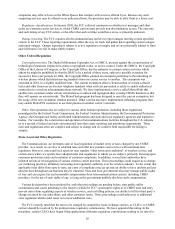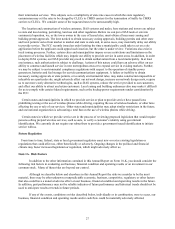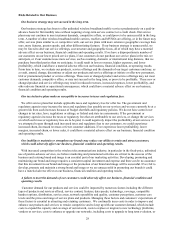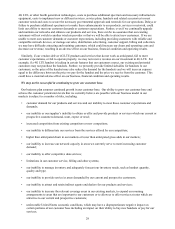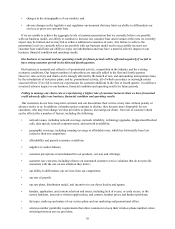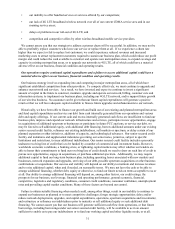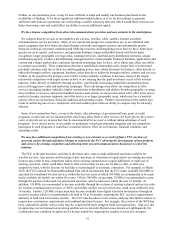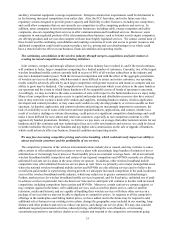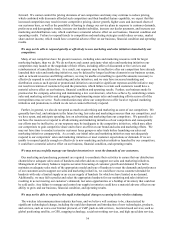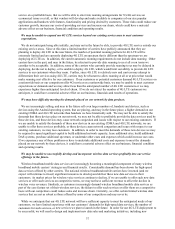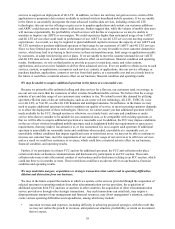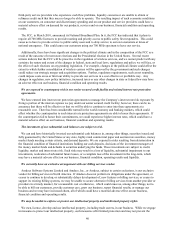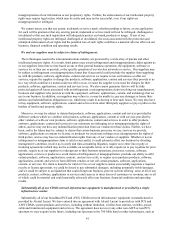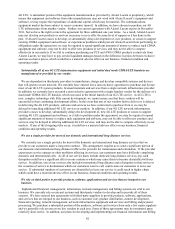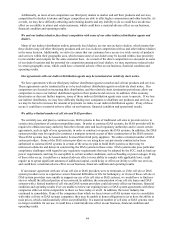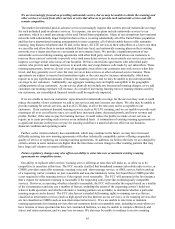Metro PCS 2010 Annual Report Download - page 45
Download and view the complete annual report
Please find page 45 of the 2010 Metro PCS annual report below. You can navigate through the pages in the report by either clicking on the pages listed below, or by using the keyword search tool below to find specific information within the annual report. 35
including streaming audio, streaming video, mobile gaming, mobile banking, music and file downloads,
advertisement paid services, video conferencing and other applications. These technological advances, evolving
industry standards, ongoing improvements in the capacity and the quality of digital technology, such as the
implementation and development of 3G technology, wideband technologies such as WiFi which do not rely on FCC-
licensed spectrum, or the development of 4G technology, such as 4G LTE or WiMax, and the development of data
and broadband capabilities, could cause the technology used by us on our wireless broadband mobile network to
become less competitive or obsolete. Additionally, VoIP is an emerging technological trend that could result in a
decrease in demand for switched telephone services, such as those we currently provide. The resulting technological
development of WiFi or WiMax enabled handsets permitting customers to communicate using voice and data
services with their handset using this VoIP technology in any area equipped with a wireless Internet connection, or
hot spots, could potentially allow more carriers to offer larger bundles of minutes while retaining low prices and the
ability to offer attractive roaming rates. The number of hot spots in the U.S. is growing rapidly, with some major
cities and urban areas approaching universal coverage. Further, the development of new equipment, such as
femtocells, could allow our competitors to offer increased usage without increased cost thus reducing our cost
advantage. As a result, competitors using more traditional and commercially proven technological advances to
provide service or using more efficient, less expensive technologies (including those not yet developed), may have a
competitive advantage over us by retaining and increasing their customer base, realizing certain economies of scale,
and receiving greater support from equipment and other manufacturers. As the CDMA infrastructure of our network
becomes less popular or obsolete, the cost of compatible equipment and technology may also increase and we may
also be subject to significant write-offs or changes in estimated useful life.
Our continued success will depend, in part, on our ability to anticipate or adapt to these and future technological
changes and to offer, on a timely basis, products and services that meet customer demands. For us to keep pace with
these technological changes and remain competitive, we may continue to make significant capital expenditures in
our networks, acquire additional spectrum, and design and offer new services. Customer acceptance of the products,
applications, content, and services that we offer will continually be affected by technology-based differences in our
product and service offerings and those offered by our competitors. We cannot assure you that we will obtain access
to new technology on a timely basis, on satisfactory terms, or on our spectrum, or that we will have adequate
spectrum, or be able to acquire additional spectrum, to offer new services or implement new technologies. If we do
not offer these applications, content, or services, we may have difficulty attracting and retaining customers. Further,
we cannot predict the effect of technological changes on our business. We also cannot be certain that the choices we
make regarding technology and new service offerings will prove to be successful in the marketplace or will achieve
their intended results. All of these factors could have a material adverse effect on our business, financial condition
and operating results.
We are dependent on certain network technology improvements, which may not occur or may be materially
delayed.
Most national wireless broadband mobile carriers have greater spectrum capacity than we do that can be used to
support 3G and 4G services. These national wireless broadband mobile carriers currently are investing substantial
capital to deploy the necessary equipment to deliver 3G or 4G enhanced services, and have invested in additional
spectrum to deliver 4G LTE services. Two of our national wireless broadband mobile competitors acquired a
significant portion of the 700 MHz spectrum auctioned by the FCC. We hold a 700 MHz license which is in a
different spectrum block than the 700 MHz licenses held by the two largest national wireless broadband mobile
competitors, which presents certain risks because some equipment manufacturers are focusing their 700 MHz
equipment development efforts on the channel blocks held by the major carriers, and the 700 MHz equipment made
by these manufacturers will not be cross-compatible for use on the 700 MHz channel block we hold. As a result, we
may be unable to use, or may be materially delayed in using, our 700 MHz spectrum. And, we may have higher
costs for devices and equipment for our 700 MHz spectrum and the prospects for both inbound and outbound
roaming may be limited on 700 MHz spectrum. Further, we are deploying 4G LTE on PCS and AWS spectrum so
unless our customer’s handsets are capable of using the 700 MHz spectrum on which our competitors are deploying
4G LTE, our customers will not be able to roam on their networks for 4G LTE services. This may affect our ability
to offer roaming on 4G LTE broadband services. The national wireless broadband mobile carriers in many instances
on average have more spectrum in each of the metropolitan areas in which we operate, or plan to operate, and may
have spectrum with better propagation characteristics. We have deployed and are selling 4G LTE services in all
except one of our major metropolitan areas. Our decision to develop 4G LTE technology has and will continue to
require significant capital expenditures. In some cases, because of the limited amount of spectrum available to us in
certain metropolitan areas, we will be required to deploy 4G LTE on 1.4 or 3 MHz channels adjacent to our existing
CDMA network in those metropolitan areas. This deployment will require engineering solutions, which may not



